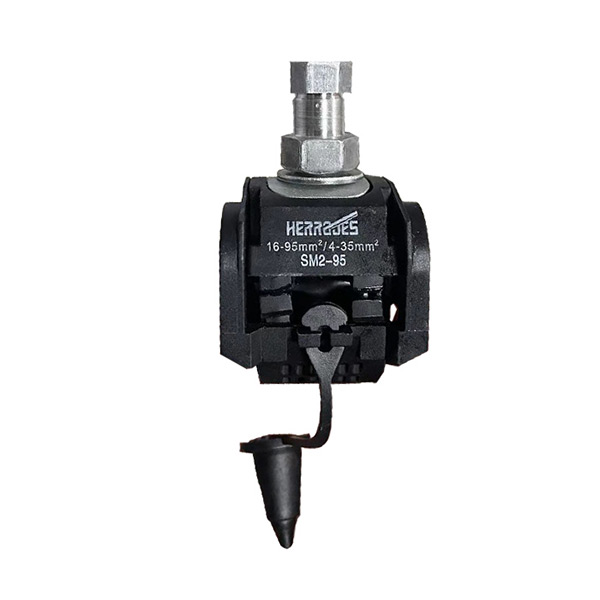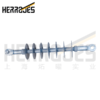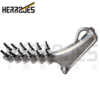The insulation piercing wire clamp
The insulation piercing wire clamp mainly consists of a reinforced shell, piercing blades, sealing pads, waterproof silicone grease, high-strength bolts, torque nuts, and cable terminal caps. When the cable needs to be branched or connected, insert the cable branch wire terminal into the waterproof terminal cap. After determining the position of the main line branch, use a socket wrench to tighten the torque nut on the wire clamp. During the process, contact with the blade will puncture the cable insulation layer and come into contact with the conductor, The sealing gasket presses around the puncture position of the cable, causing silicone grease to overflow from the shell. When the torque reaches the set value, the nut torque mechanism falls off, the main and branch lines are connected, and the waterproof performance and electrical effect meet the standard parameters.
Brief introduction
The insulation piercing wire clamp mainly consists of a reinforced shell, piercing blades, sealing pads, waterproof silicone grease, high-strength bolts, torque nuts, and cable terminal caps. When the cable needs to be branched or connected, insert the cable branch wire terminal into the waterproof terminal cap. After determining the position of the main line branch, use a socket wrench to tighten the torque nut on the wire clamp. During the process, contact with the blade will puncture the cable insulation layer and come into contact with the conductor, The sealing gasket presses around the puncture position of the cable, causing silicone grease to overflow from the shell. When the torque reaches the set value, the nut torque mechanism falls off, the main and branch lines are connected, and the waterproof performance and electrical effect meet the standard parameters [1].
Advantage
It has the characteristics of easy installation, low cost, safety, reliability, and maintenance free. No need to cut off the main cable or peel off the insulation layer of the cable to make cable branches. The joints are completely insulated and can be used for live working. It can be used as on-site branches at any position of the cable. There is no need to use terminal boxes or distribution boxes. And the joint is resistant to twisting, shockproof, waterproof, and corrosion-resistant to aging. The use of insulation piercing wire clamps for cable branching has significant comprehensive benefits and better cost-effectiveness than traditional connection methods in the past.
Installation method
Installation of single screw insulation piercing wire clamp
1. Adjust the puncture wire clamp nut to the appropriate position and fully insert the branch wire into the branch wire cap.
2. Insert the main line, and if the main line has two layers of insulation, remove a certain length of outer insulation at the connection position.
3. Place the main/branch line in the appropriate position and keep it parallel. First, tighten the nut by hand and secure the clamp.
4. Tighten the nut evenly with a socket wrench of corresponding size until the top breaks and falls off, and the installation is complete.
Installation of Double Screw Insulated Puncture Clamp
1. First unscrew the wire clamp and clip the main line into the main slot, do not tilt the main line with the cutting edge. Pay attention to whether the wire diameter range corresponds to this wire clamp.
2. Put the branch line into the branch slot again. The same precautions apply.
3. Tighten with a socket wrench. Prohibit open end wrenches.
4. Note that the two nuts should be tightened synchronously and downwards in sequence.
5. When tightening to a certain force, the constant torque nut is broken and the installation is completed [1].
classification



